In this blog post, read the biography of Helen Keller, a deaf and blind woman who overcame her disabilities and became an American political activist, author, and lecturer.
Helen Keller
Unlike many other deaf and blind people, Helen Heller was not born deaf and blind. She was born a healthy child. However, when she was almost 19 months old, she contracted an illness that left her deaf and blind. This devastated her world as it took away her ability to understand the things happening around her. Despite her disabilities, she accomplished several feats that made her famous throughout the world. When she was 23 years old, she published her first book. At the age of 24, she became a graduate, a feat not achieved by any other deaf-blind person before. At the age of 33, she became a lecturer for the American Foundation for the Blind.

The biography of Helen Keller – By Unknown author – This image is available from the United States Library of Congress‘s Prints and Photographs division under the digital ID cph.3c12513. Public Domain, Link
She traveled the world and worked for the cause of women’s rights, labor rights, and anti-militarism. How can a woman who couldn’t even see or hear become one of the best humanitarians of the twentieth century? Read the biography of Helen Keller to find out how she overcame her disabilities. Get a glimpse into her tragic yet profound story.
Childhood
Birth
Helen Keller was born in 1880 in Alabama to Arthur Henry Keller and Catherine Everett Keller. Her father was a newspaper editor and a captain in the Confederate Army. Her mother was the daughter of a general in the Confederate Army. Helen Keller had two siblings and two half-siblings from her father’s earlier marriage. Contrary to most cases, Helen was not born blind and deaf. She was healthy when she was born.
Mysterious illness
When she was 19 months old, Helen Keller contracted a mysterious illness, which left her deaf and blind. It was described by doctors as an acute congestion of the brain and stomach. Reports later suggested that the disease could have been meningitis or scarlet fever. This illness left Helen completely devastated. She had no idea of what was going on around her as nobody knew how to communicate with her. With age, Helen learned a few signs that helped her convey her needs to her family. When she was seven years old, she could even identify people using the vibration from their footsteps.
The unruly kid
Her parents showed extra care for her because of her disability. Since she was a kid, she used this to her advantage and got whatever she wanted by throwing temper tantrums. She dominated the entire household and terrorized the servants.But her parents did not do anything against it because they did not know how to communicate with her. So, they gave in to her tantrums, instead of teaching her to behave properly.
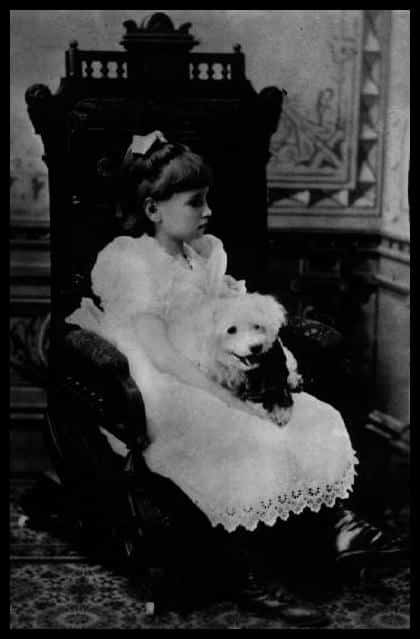
A picture of Helen Keller with her dog, 1887
Inability to form sentences
Sentences are the basic building blocks of languages. But sentences themselves are made up of different words like nouns, verbs, prepositions, etc. So, we can say that learning a language without learning its words is impossible. However, Helen did not know about the existence of words. So, she did not know that everything around her has a name, and she can refer to an object using its name. For example, she can touch a table and know that it is there. But she didn’t know that a table can be called a table. Since she did not know the existence of words, she couldn’t form sentences either. So, she couldn’t form proper thoughts inside her brain since most of our thoughts are in the form of sentences. This could have, in turn, frustrated her and made her unruly and wild.
One book that changed everything
When she was six years old, her mother was reading American notes, written by Charles Dickens. It contained his findings during his six-month trip to North America. In it, Charles Dickens had written about a deaf-blind girl called Laura Bridgman born fifty years before Helen Keller. Like Helen, she had also lost her ability to see and hear when she was two years old. Charles Dickens mentioned that she was successfully educated in the English language.
Reading this, Helen’s mother became hopeful. She immediately sent Helen and her father to visit an ear, nose, and Throat specialist. He referred Helen to Alexander Graham Bell, who, in turn, referred her to the Perkins Institute for the Blind. This is the same institute where Laura Bridgman had studied.
The Perkins Institute for the Blind sent an old student called Anne Sullivan to teach Helen Keller.
Her mentor
Like Helen Keller, Anne Sullivan had vision problems. When she was five years old, she had contracted an eye disease that left her mostly blind. After joining The Perkins institute for the blind, she underwent eye surgeries that significantly improved her vision. She learned sign language, which is used to communicate with deaf people, from Laura Bridgman and graduated when she was 20 years old. Soon after graduating, she was sent to teach Helen. The first word that Anne taught Helen was ‘doll.’ She gave a doll to Helen, which she took gladly. Then she spelled the letters ‘d,’ ‘o,’ ‘l,’ ‘l’ on Helen’s other hand. Helen learned the letters quickly and imitated Anne’s actions to spell the same word. This indicated to Anne that Helen was intelligent and can be taught.
Meeting her mentor
When Anne Sullivan first met Helen Keller, she was an unruly kid. She ran around the house breaking things and eating from others’ plates. Anne was astonished that none of Helen’s family members did anything to stop her behavior or teach her to behave properly. Anne noticed that her family’s sympathy only encouraged Helen to continue being unruly. She understood that she must discipline Helen without using force.Anne felt that the first step to teaching Helen was to teach her how to behave properly. So, with the permission of Helen’s family, Anne took custody of Helen for two weeks. During these two weeks, Anne was the only person Helen could depend on. Therefore, Helen couldn’t run to her parents when Anne tried to discipline her. During these two weeks, Helen learned to behave properly. In addition to that, Helen learned several words from Anne. She could spell them out on Anne’s hands. But she was just imitating what Anne was doing, just like a monkey. She thought it was a game. She did not understand that each of these words had meaning and referred to an object. Anne did not know how to make Helen understand that each of these was a word and had a purpose.
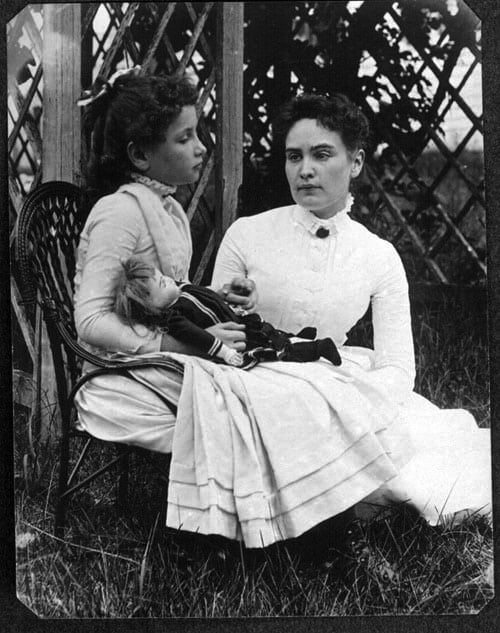
A picture of Helen and Anne in 1888 – By Family member of Thaxter P. Spencer, now part of the R.Stanton Avery Special Collections, at the New England Historic Genealogical Society. See Press Release [1] for more information. – New England Historic Genealogical Society, Public Domain, Link
The breakthrough
In her frustration, Anne took Helen to a water pump. She put one hand of Helen under flowing water, and on the other hand, she spelled out the letters ‘w,’ ‘a,’ ‘t,’ ‘e,’ ‘r.’ It was only then that Helen had the revelation that this flowing substance had a name, called water.
Helen later remembered the event as:
I knew then that ‘w-a-t-e-r’ meant the wonderful cool something that was flowing over my hand. That living word awakened my soul, gave it light, hope, joy, set it free.
Helen bent down immediately, touched the earth, and demanded its name. Soon, she learned other words, and by the end of the day, knew 30 words and their meanings. Helen later described this meeting as ‘Her soul’s birthday.’ This signaled the beginning of a 49-year relationship between Anne and Helen.
This interaction between Anne and Helen is brilliantly portrayed in the film ‘The Miracle Worker.’
Formal education:
Helen’s formal education began in 1888 when she and Anne moved to the Perkins institute. In 1894, they moved to New York for her higher studies at the Horace Mann School for the deaf. In 1896, she got admission into ‘The Cambridge School for Young Ladies.’ In 1900, she started her Bachelor’s degree in ‘Radcliff College’ of ‘Harvard University.’ It was unthinkable at that time and age for a deaf and blind woman to achieve proper formal education through such reputed institutes. But Helen had a thirst for knowledge, and Anne helped her quench it. Mark Twain, who was impressed with Helen and her perseverance, introduced her to an oil magnate who later sponsored Helen’s education. In 1904, Helen graduated with a Bachelor of Arts degree from Radcliffe School. She was the first deaf-blind person to get this degree.
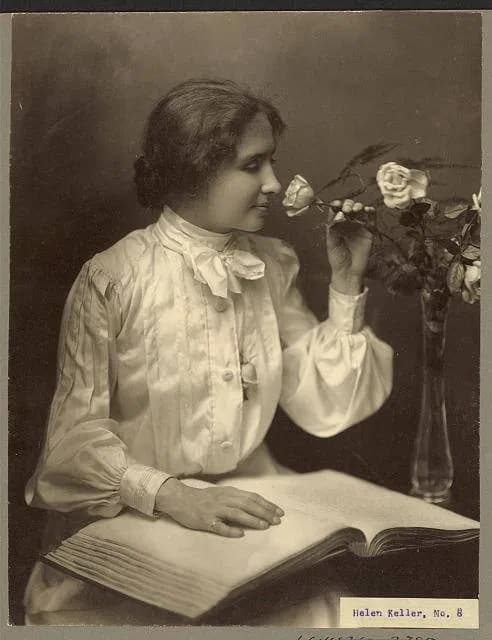
Learning to speak:
Helen was determined to converse with people conventionally. So, she slowly began reading lips with her hands and speaking small sentences. She used sign language very proficiently and became an expert in Braille, the writing system used for the visually impaired.
Helen spent the rest of her life, giving speeches and lectures on how she overcame the disabilities that crippled her and became an inspiration to deaf and blind people across the world. She shared, ‘The joy that life gave her’ in her speeches and motivated young women and men to live life to the fullest.
Optimism is the faith that leads to achievement. Nothing can be done without hope and confidence – Helen Keller (Source)
Personal life
Love affair
The biography of Helen Keller would be incomplete without mentioning her love life.
When she was in her mid-thirties, Helen had a secret love affair with a fingerspelling specialist sent to her home to be with her when Anne fell ill. She even tried to elope with him and got secretly engaged. The affair ended soon after when Helen moved in with her mother in Alabama after her father’s death.
Companions
In 1905, Anne married John Macy. Anne, John, and Helen moved to Forest Hills in New York along with the house help, Polly Thomson. Anne’s health began to deteriorate in 1915. So, Polly started taking care of Helen. Anne died in the year 1936 with Helen by her side. After Anne’s death, the household help Polly became Helen’s companion. They both traveled the world together and raised money to help blind people. Polly died in the year 1960, and Helen was left with a nurse who was originally hired to look after Polly. She remained with Helen until her death in the year 1968.
Work
Books and Lectures
Helen authored a total of 12 books and many articles. She toured 35 countries to raise awareness about causes she was passionate about. The Helen Keller foundation was founded in the year 1915 for research and charitable purposes.
Helen felt strongly about the causes she supported and was a staunch supporter of the working class. She traveled to many countries to motivate deaf and blind people and became a favorite of the masses.
The biography of Helen Keller
At the age of 22, Helen published ‘The Story of My Life,’ her autobiography with the help of Anne.
Bettering the life of blind people
Before Helen’s time, blind and deaf people were considered a burden for the family. They were treated harshly and sent to live in asylums, where the living conditions were terrible. Nobody thought that they could contribute anything to society. But Helen Keller changed all that.
She proved to the world that when provided with proper guidance and support, blind and deaf people can accomplish great things. This not only motivated blind and deaf people but also taught others to treat them better.
During Helen’s time, four systems were used to teach the visually impaired to read and write. This caused confusion and difficulty when blind people wanted to communicate with each other. Due to Helen’s continued efforts, in 1932, Braille was made the standard system to teach blind people. This made it easy for blind people to communicate with each other.
She traveled to different countries to help visually challenged people. Her visits created real improvements in the form of more Braille books, better educational opportunities, and job training for the blind. These improvements have helped blind people to integrate with society.
She also pushed the U.S. government to provide more assistance to the blind. Her fundraising campaigns for the American Foundation for the Blind continue to help blind people get proper education, work training, and live independently.
Contribution in other areas
Helen also supported birth control and was against military intervention. She joined the famous international labor union called ‘Industrial Workers of the World’. She wrote for them from 1916 to 1918, highlighting workers’ plights and the greed of their employers.
Political Ideology
Helen was a radical socialist who opposed Woodrow Wilson and favored leftist political ideologies. She was a member of the socialist party and spread awareness through her writings on the rights of women and the impacts of war. She met 13 U.S. presidents. Helen even wrote a series of essays on socialism called ‘Out of the dark.’
Death
In her last years, Helen was mostly confined to her home after suffering a series of strokes. She continued to raise awareness through The American Foundation for the Blind. Helen continued to raise funds for them too. On 1st June 1968, she passed away peacefully in her sleep at her home in Connecticut.
Honors and Memories
A hospital in Alabama, The Helen Keller Hospital, is dedicated to Helen. Alabama honored her by issuing a coin in Braille in her name. Helen Keller is also inducted in the National women’s hall of fame and Alabama Women’s hall of fame. She was one of the inaugural inductees in the Alabama Writer’s hall of fame as well. Various movies and T.V. series were made on Helen’s life and were loosely based on her autobiography. The Bollywood movie “Black” was based on her life.

Picture of the coin depicting Helen Keller -By Image:Alabama quarter, reverse side, 2003.png, Public Domain, Link
Facts you probably didn’t know
- Helen Keller and Mark Twain were good friends. They both were radical socialists. It was Twain who gave Anne Sullivan the name ‘Miracle Worker.’
- Helen’s family got a whiff of her affair with her male secretary and forbade the two of them to marry because of her disabilities. Helen said that the first thing she would do if she could see would be to get married.
- She introduced the U.S. to the dog breed ‘Akita,’ which was gifted to her when she toured Japan.
- She won an Oscar for her documentary “Helen Keller in Her Story” (Source).
- Helen was an excellent typist and could type very fast in both standard typewriter and Braille typewriter.
- Due to her radical political views, the FBI tracked Helen’s relationships and activity for almost 30 years. (Source)
We hope that the biography of Helen Keller helped you understand Helen Keller’s struggles and how she overcame them. Due to her resolve and the desire to learn new things and help others, she is remembered even today. Whenever life gets difficult, read the biography of Helen Keller and always remember what she said:
Although the world is full of suffering, it is also full of the overcoming of it – Helen Keller
(Reference – Mullins-Cohen, Gina. “Showing Our Resolve.” Parks & Recreation, vol. 53, no. 1, National Recreation and Park Association, Jan. 2018, p. 10.)
Did you like reading the biography of Helen Keller? Then, you may like the following posts too:
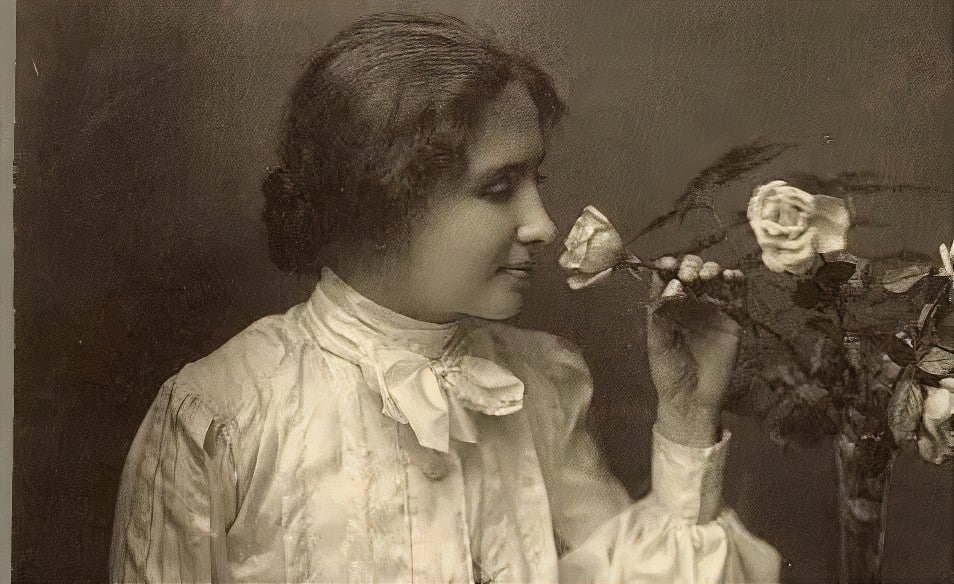
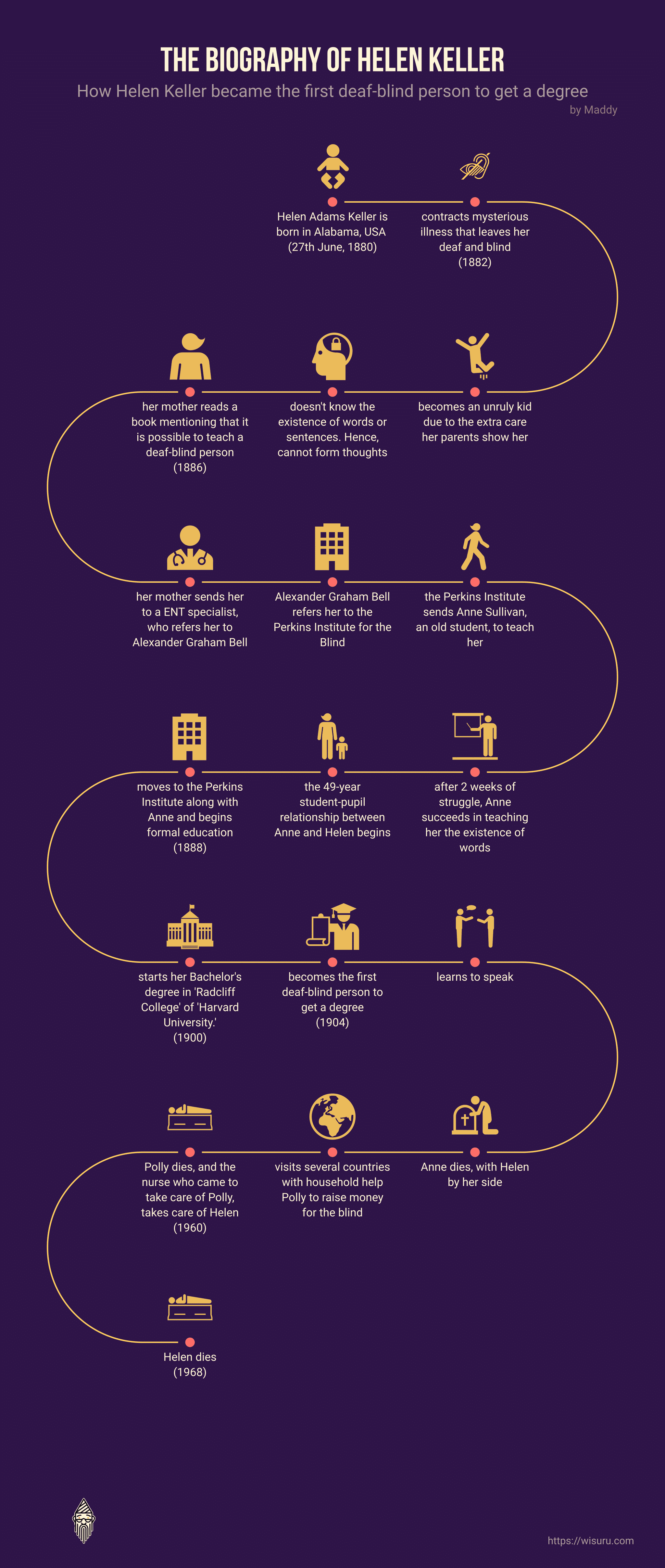
Leave a Reply